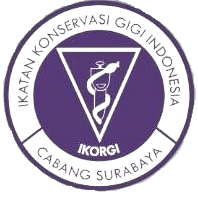Inhibitory effect of nano Stolephorus insularis and calcium hydroxide on glucosyltransferase (GTF) activity of Lactobacillus aciophilus
Downloads
Background: Dental caries is the most common multifactorial infectious disease worldwide which referes to the process of destruction tooth hard tissue caused by bacterial by-products in the form of acids through carbohydrate fermentation. Lactobacillus acidophilus is one of the main cariogenic bacteria that causes caries by forming biofilms with the help of
glucosyltransferase (GTF) enzymes. Calcium hydroxide has limited antibacterial effects. Nano brown anchovy contains fluor as the active compound which has the potential as an antibacterial alternative agent. Purpose: To explain the inhibition of the combination of nano Stolephorus insularis and calcium hydroxide on the activity of the glucosyltransferase enzyme of Lactobacillus acidophilus bacteria. Methods: This study used a combination of nano Stolephorus insularis 3.125% with calcium hydroxide as a treatment and aquades as a control. The GTF enzyme was obtained from the supernatant centrifuged by Lactobacillus acidophilus in BHIB. The activity of the GTF enzyme was considered by calculating the fructose levels using High Performance Liquid Chromatography (HPLC) in a certain formula.
Results: Decreased levels of fructose was obtained in the treatment group. From the results of Mann- Whitney data analysis, there were significant difference in the study groups. Conclusion: the combination of nano Stolephorus insularis with calcium hydroxide is effective to inhibit the glucosyltransferase enzyme activity of Lactobacillus acidophilus bacteria.
Pribadi, N., Widjiastuti, I. and Nadia,A. (2020) ‘Effect of Calcium Hydroxisw-Propolis Combination on The Number of Fibroblas Cells and
Angiogenesis in Wistar Rats Pulp',Conservative Dentistry Journal, 10(1),
pp. 14–18.
Prakash, S. and Yadav, K. (2016) Dental Caries: A Review', Asian
Journal of Biomedical and Pharmaceutical Sciences, 8(7), pp.76-
Widjiastuti, I., Soetojo, A. and Cahyani,F. (2017) ‘Anti-glucan effects of
propolis ethanol extract on Lactobacillus acidophillus', Dental
Journal (Majalah Kedokteran Gigi),50(1), p. 28.
Effendy, R., Ariesta, V. and Saraswati,W. (2019) ‘Antibacterial Potency of
Calcium Hydroxide and Propolis Mixture on Mixed Bacteria of Carious
Dentin', Conservative Dentistry Journal, 9(1), pp. 5–12.
Ba-Hattab, R. et al. (2016) ‘Calcium Hydroxide in Endodontics: An
Overview', Open Journal of Stomatology, 6(12), pp. 274–289.
Yuanita, T. et al. (2022) ‘Antibacterial Potency of Nano Brown Anchovy
(Stolephorus insularis) on Lactobacillus acidophilus and Aggregatibacter
actinomycetemcomitans', Teikiyo Journal, 6(3) pp.65-71.
Moraes, G., Zambom, C. and Siqueira,W.L. (2021) ‘Nanoparticles in dentistry: A comprehensive review',Pharmaceuticals, 14(8).
Al Husyaerry, M. and Setiawan, A.S. (2018) ‘Efektivitas Partikel Nano dalam
Pencegahan Karies | Indonesian Journal of Paediatric Dentistry', Journal of
Indonesian Dental Association, 1(1),pp. 111–113.
Amanda, Kunarti, S. and Subiwahjudi,A. (2017) ‘View of Daya Hambat
Aktivitas Enzim Glukosiltransferase (Gtf) Streptococcus mutans Oleh
Ekstrak Temulawak (Curcuma Xanthorrhiza Roxb.)', Conservative Dentistry Journal, 07(01), pp. 32–36.
Dubey, A. et al. (2016) Calcium hydroxide in dentistry: A Review.
Calcium Hydroxide in Dentistry,Chettinad Health City Medical Journal,
(10), pp. 123-128
Kulshrestha, S. et al. (2016) ‘Calcium fluoride nanoparticles induced
suppression of Streptococcus mutans biofilm: an in vitro and in vivo
approach', Applied microbiology and biotechnology, 100(4), pp. 1901–1914.

This work is licensed under a Creative Commons Attribution 4.0 International License.

CDJ by Unair is licensed under a Creative Commons Attribution 4.0 International License.
1. The journal allows the author to hold the copyright of the article without restrictions.
2. The journal allows the author(s) to retain publishing rights without restrictions










